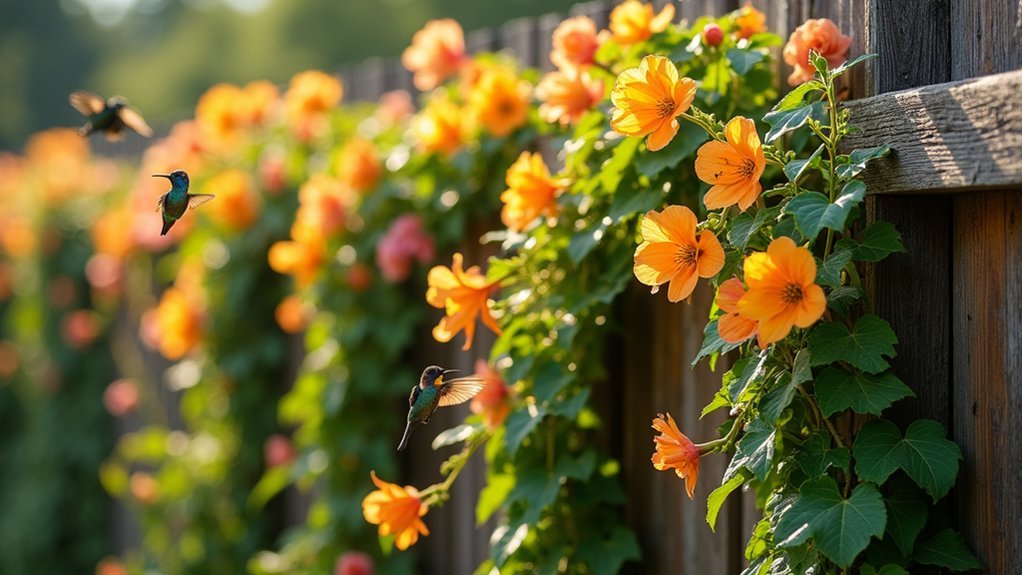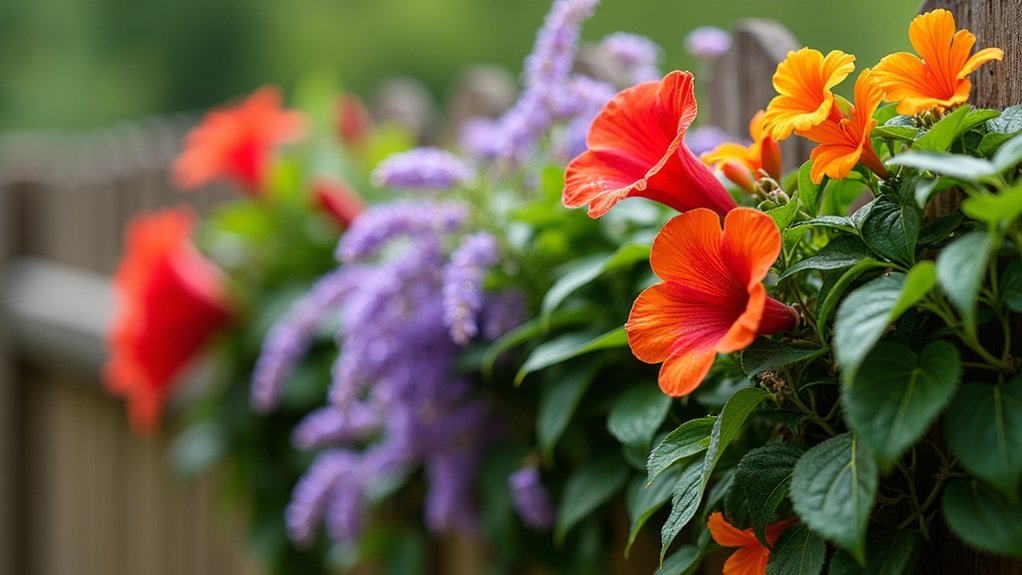Honeysuckle, trumpet vine, and salvia create a hummingbird haven along your fence line. These stunning plants offer vibrant blooms and sweet nectar that attract these tiny flyers all season long. Honeysuckle and trumpet vine climb dramatically upward, reaching 20-30 feet, while salvia’s purple spikes provide eye-catching contrast below. You’ll enjoy both beautiful vertical interest and the delightful sight of hummingbirds hovering nearby. Discover how these fence-friendly options transform your garden into a pollinator paradise.
Climbing Vines: Honeysuckle and Trumpet Vine for Vertical Appeal

When you’re looking to transform your fence into a hummingbird haven, climbing vines offer the perfect solution.
Honeysuckle dazzles with its sweet nectar and bright red-toned petals, blooming year-round in USDA zones 5 to 9. These beauties can reach impressive heights of 12 to 20 feet, creating a stunning vertical display.
Vibrant honeysuckle vines entice hummingbirds with nectar-rich blooms while transforming fences into living walls of color.
For dramatic impact, pair honeysuckle with Trumpet Vine. This aggressive climber showcases tubular flowers that hummingbirds love, and can soar up to 30 feet in just one season.
Both climbing vines thrive in full sun conditions, making them ideal for vertical gardening along fences or trellises.
Flowering Shrubs: Bee Balm and Butterfly Bush as Living Barriers
Unlike traditional fencing materials, flowering shrubs create dynamic living barriers that serve multiple purposes in your garden.
Bee Balm, with its vibrant colors and tubular blooms, thrives in zones 3-9 and attracts hummingbirds throughout its long flowering season. Plant this perennial in full sun and well-draining soil to enjoy its 1-4 foot mature spread.
For taller living barriers, consider Butterfly Bush. Growing up to 12 feet in zones 5-9, its elongated clusters of nectar-rich blooms create a privacy screen while providing essential pollinator support.
Both shrubs adapt to various soil conditions while offering hummingbirds the nutrition they need.
Colorful Perennials: Salvia and Columbine for Fence-Line Beauty

Beyond the living fence structures of shrubs, perennial flowers can transform your fence line into a thriving hummingbird haven. Salvia and Columbine are standout colorful perennials for this purpose, both highly attractive to hummingbirds.
Salvia showcases vibrant flowers on striking spikes, thriving in full sun across USDA zones 4-10. Its companion, Columbine, charms with delicate foliage and tubular-shaped flowers in various colors, adapting well to zones 3-8.
Plant these perennials in masses along your fence for maximum visual impact. You’ll enjoy their long blooming season, providing a continuous nectar source throughout summer.
Both selections contribute to pollinator-friendly gardens while creating a stunning backdrop. Their reliability year after year makes them perfect investments for fence-line beauty that supports your local ecosystem.
Frequently Asked Questions
What Is the Most Attractive Plant for Hummingbirds?
Trumpet vine and bee balm are top contenders for attracting hummingbirds. You’ll have the most success with bright red, tubular flowers that provide abundant nectar throughout the growing season.
What Is a Ruby-Throated Hummingbird’s Favorite Flower?
Ruby-throated hummingbirds adore trumpet vine and honeysuckle as their favorite flowers. You’ll find they’re drawn to tubular red, orange, and pink blooms that offer rich nectar and match their slender bills perfectly.
What Is a Hummingbird’s Favorite Hanging Plant?
You’ll find that fuchsia is a hummingbird’s favorite hanging plant. They’re attracted to its exotic purple, pink, and red flowers. Cuphea is another excellent choice, blooming into fall and providing eye-level feeding opportunities.
What Is the Purple Plant That Hummingbirds Love?
Hummingbirds love several purple plants you can grow: Bee Balm (Monarda), Larkspur (Delphinium), Agastache (Blue Boa), Dark Matter™ Salvia, and Coral Bell (Heuchera). They’re all rich in nectar and feature tubular flowers hummingbirds adore.
In Summary
You’ll transform your fence into a hummingbird haven with these stunning plants. Whether you’ve chosen honeysuckle’s vertical drama, butterfly bush’s fragrant barrier, or salvia’s colorful edge, you’re creating more than just boundary lines. You’re building a living ecosystem that attracts these jewel-toned visitors throughout the season. Plant strategically, water consistently, and you’ll soon enjoy the magical sight of hummingbirds hovering among your fence-line blooms.





Leave a Reply